Opportunities for involvement in a National Science Foundation (NSF) research project are rare, especially for an undergraduate student. Senior Marissa Rotar became involved in research when she was asked to be the undergraduate teaching assistant for a new honors course involving mountain pine beetle research. This course as an honors colloquium connects a five-year NSF study with students from The Colorado School of Mines (CSM) and Colorado State University (CSU). The colloquium is set up so that students from each school communicate through an online interface that allows them to interact as if they were in the same room. Rotar helps to facilitate the class as well as contribute to the conversation. The opportunity for Rotar came about after taking courses with Human Dimensions of Natural Resources Associate Professor Stuart Cottrell who then recognized her strengths as a student and offered her the position as teaching assistant for the colloquium. The broader content for this course is from a study, involving many biophysical and social scientists, including Reed Maxwell and his team from the Colorado School of Mines, Warner College of Natural Resources Post Doctorate Kathie Mattor, Professor John Stednick, and Cottrell.
Rotar has always had a passion for traveling and culture. So naturally, after bouncing around in a couple of other majors, she ended up in Natural Resource and Recreation Tourism with a concentration in Global Tourism in HDNR. Additionally, she is double minoring in Spanish and Business Administration as well as being an honors student.
This colloquium is unique in many ways, especially with the collaboration between CSM and CSU. Cottrell received a TILT Learning Service grant as support for the colloquium to hire an undergraduate teaching assistant (Rotar) and provide travel resources for students to participate in their outreach efforts. By facilitating two different sets of classrooms and students collectively, Rotar has learned a lot about how different learning environments can produce different student perspectives about the environment and the associated issues, “There’s very much a split between an [anthropocentric] and [biocentric] view between an engineering school and an agricultural school. Its really unique to see both come together in such an environment where everyone’s free to talk about their differing opinions to find out where people connect and where they disconnect.” Together, the different groups of students discuss and collaborate on issues related to the threat of the Mountain Pine Beetle and how to effectively assess perceptions, and subsequently communicate with and educate stakeholders. From the colloquium content and associated discussions, these students will actually develop outreach modules to present to students at local schools in both Golden and Fort Collins.
Rotar’s involvement in an NSF project is rare for an undergraduate student and she has taken advantage of the opportunity with hopes to apply lessons learned to her passion for sustainable tourism development, “It’s [being a teaching assistant] become an opportunity for me to really solidify what I want to do with my future and understand everything I’m hoping to get out of my education here at CSU.”
The platform for the class has been centered around the Mountain Pine Beetle and the research done in collaboration between Cottrell, Mattor and Stednick from CSU with interdisciplinary environmental scientists from the Colorado School of Mines. Recently, an article from a parallel bark beetle working group with representatives from the CSU NSF project team was published in the Journal of Applied Ecology. Their research includes the application of the science that the college students may use in their outreach with K-12 students as part of the last phase of the five-year NSF study. With published project related work available, the students will learn about the research while developing ways to communicate it. The colloquium has two purposes, one as part of the final outreach stage of the NSF project and the other as a class for honors students. Rotar’s position as a teaching assistant allows her to partake in the last phase of the project as an undergraduate student while learning about effective place based science communication.


